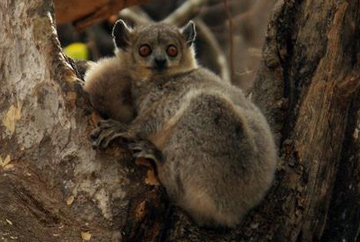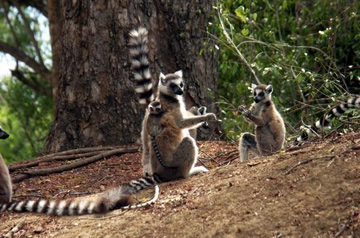Aye-aye diverged from other lemurs 66M years ago
Aye-aye diverged from other lemurs 66M years ago
wildmadagascar.org
February 25, 2008
|
|
The aye-aye — a bizarre, nocturnal lemur that taps on trees with its fingers to find its insect prey — was the first of its family to branch off from the rest of the lemur line some 66 million years ago, report Duke researchers writing in the March 1 issue of Genome Research.
Analyzing the DNA of more than 200 lemurs and related primates, the Duke team sorted out the family tree for lemurs, which in addition to the aye-aye, includes four evolutionary lineages: “the sifakas, named for the hissing ‘shee-fak’ sound they make; the sportive lemurs, which are strictly nocturnal; the mouse lemurs, the smallest of all living primates; and the many so-called ‘true lemurs,'” which include the best known lemurs like the ringtailed and black lemurs.
 White-footed lepilemur (Lepilemur leucopus) in Madagascar. Photo by Rhett A. Butler |
“By throwing this much data at the problem, we have absolutely confirmed, beyond any statistical doubt, that the spectacular array of lemurs all descended from a single ancestral species,” said Anne Yoder, Director of the Duke Lemur Center and a co-author of the research. “It further highlights the importance of Madagascar as a cradle for biodiversity.”
Yoder says that lemurs account for about 20 percent of known primate species and live on less than one percent of Earth’s surface.
About 75 percent of the species found on Madagascar, the world’s forth largest island, are found nowhere else.
Lemur history
Madagascar lacks the dominant form of primate distributed worldwide, those of the suborder Haplorhini (monkeys, chimps, gorillas, and Homo sapiens). Instead, their niche has been filled by an older group of primates, the lemurs. Lemurs belong to the sub-order Strepsirhini together with bushbabies, lorises, and pottos which—like the original lemurs—are nocturnal, insectivorous primates characterized by a small body, a long nose, and large eyes. Lemurs have an interesting evolutionary history and the only reason they still exist today is because of Madagascar’s isolation.
Until around 160 million years ago, Madagascar was attached to the African mainland as part of the super continent Gondwanaland (formed of Africa, South America, Australia, Antarctica, India, and Madagascar). As Gondwanaland broke apart, Madgascar moved away from Africa. The first lemur-like primates on the fossil record appeared roughly 60 million years ago in mainland Africa and crossed over to Madagascar shortly thereafter.
 Ringtailed lemur (Lemur catta) in Madagascar. Photo by Rhett A. Butler |
The island continued to drift eastward and by the time monkeys appeared on the scene 17-23 million years ago, Madagascar was isolated from their arrival. As highly intelligent and adaptive primates, monkeys quickly drove the lemur lineage elsewhere in the world toward extinction (a few Strepsirhines—including bushbabies, lorises, and pottos—managed to hang on by retaining their nocturnal, solitary, and insectivorous traits).
Madagascar’s lemurs—isolated from evolutionary changes of the world—radiated into the large island’s many niches without much competition or predation. Today lemurs are found in virtually all of Madagascar’s ecosystems and share some of the social and behavioral characteristics of monkeys (i.e., forming social groups, eating fruit and vegetation, and being active during the day).
Upper primates did not reach Madagascar until about they learned to navigate the high seas and arrived on boats roughly 2,000 years ago. Humans quickly went to work on the island’s lemurs, reducing the number of species found in Madagascar by at least 15. The largest species suffered the most and today the largest remaining lemur is the Indri which would have been dwarfed by the gorilla-sized species once found on the island. Currently all lemurs are endangered species, due mainly to habitat destruction (deforestation) and hunting.
Today Madagascar is home to nearly 60 “taxa” of lemurs (species, sub-species, and populations from 33 species across five families and 14 genera) ranging in size from the 25-gram pygmy mouse lemur to the indri. All these species are endemic to Madagascar (two lemur species were introduced to the Comoros) giving the country the second highest number of primate species after Brazil, which has 77 species (only two endemic genera and no endemic families). And new species are still being discovered—primate researchers speculate that 10-20 new species of lemurs may be described over the next generation.